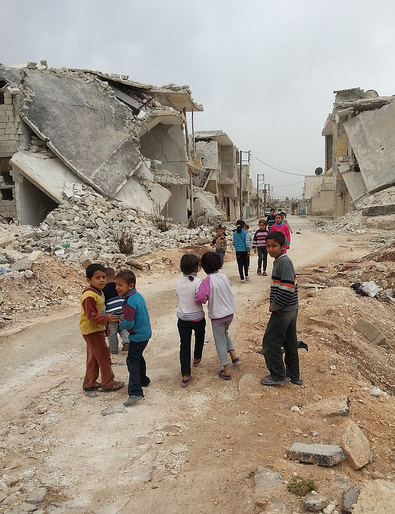
Children in Azaz, Aleppo governorate in Syria (© IHH Humanitarian Relief Fondation https://flic.kr/p/mC9de1)
The International Network on Explosive Weapons (INEW) held an international campaign conference in Geneva, on Thursday 31 August for organisations concerned about the use of explosive weapons in populated areas and humanitarian harm resulting from this practice. The conference was open to members and other organisations concerned about the humanitarian harm resulting from the use of explosive weapons in populated areas, and around 60 campaigners participated from around 20 countries. The aim of the conference was to engage participants on the following:
- Understanding the humanitarian harm that results from the use of explosive weapons in populated areas;
- Providing recommendations to states and other actors on action needed to reduce harm including stronger national policies and procedures, and new international standards;
- Planning activities that civil society organisations can undertake, including research, advocacy and outreach to governments and parliamentarians, public campaigning and media.
Iain Overton of Action on Armed Violence (AOAV) presented key data on the civilian casualties from the use of explosive weapons in populated areas. This was based on their most recent annual data set and report “Explosive truths: monitoring explosive violence in 2016“. AOAV recorded 45,624 deaths and injuries by explosive weapons in 2,300 incidents in 2016. Of these, 32,088 were civilians – 70%. When explosive weapons were used in populated areas, 92% of those killed and injured were civilians. This compares to 25% in other areas. Syria, Iraq, Yemen, Afghanistan, and Turkey saw the highest number of civilian deaths and injuries in 2016.
Roos Boer of PAX presented on the technical aspects of explosive weapons, looking at characteristics and effects of explosive weapons and identifying some common types. The presentation showed why explosive weapons with wide area effects – including weapons with a large blast radius, inaccurate weapons, and weapons that scatter explosives over a wide area – and how they present a particularly high risk to civilians, and as such, are inappropriate for use in populated areas. This presentation was based on a report “Areas of harm: Understanding explosive weapons with wide area effects” produced with Article 36.
Mark Hiznay of Human Rights Watch presented research undertaken on the use of explosive weapons in Mosul, Iraq published in June 2017. Research documented the use of unguided munitions from mortars and multi-barrel rocket launchers, and the use of IRAMs into the Old City of West Mosul causing high levels of civilian casualties. In response to these findings, HRW and other organisations including INEW called on all warring parties to stop the use of explosive weapons with wide area effects in the city of Mosul which is densely populated.
Alma Taslidžan Al-Osta of Handicap International presented on the humanitarian harm resulting from the use of explosive weapons in populated areas. Her presentation looked at the causes and types of injuries sustained from the use of explosive weapons in populated areas as well as psychological trauma. It looked at both the direct impacts on people causing death, injury and trauma as well as longer term impacts though destruction of essential infrastructure and services, presenting challenges to recovering from conflicts as well as triggering displacement.
Bonnie Docherty of Harvard Law School’s International Human Rights Clinic presented field research undertaken with PAX looking at the impact of the use of explosive weapons in Ukraine in 2014 and the direct and indirect impact on health care system and on patient care. The use of explosive weapons have damaged hospital buildings, ambulances, shut down power supplies, and presented travel risks for ambulance personnel and civilians. It found that the use of EWIPA has infringed on the availability, accessibility and quality of healthcare.
INEW Coordinator Laura Boillot, spoke about efforts to address the harm from the use of explosive weapons in populated areas, including the establishment and call of INEW, and the calls of the UN Secretary-General and the ICRC to avoid the use of explosive weapons with wide area effects in populated areas, and recognition by states of the harm so far. She spoke about commitments that could be developed in an international political declaration as a tool to address harm, including requiring states to stop use of explosive weapons with wide area effects in populated areas, the development national level operational policies to shape practice, assistance to victims, reconstruction of infrastructure, and data gathering.
Simon Bagshaw of OCHA spoke about the forthcoming publication “Compilation of Military Policy and Practice” on strengthening the protection of civilians from the use of explosive weapons in populated areas, and positive examples where military forces, such as the International Security Assistance Force in Afghanistan and the African Union Mission in Somalia, have instituted policy and practice that place limits on the use of certain explosive weapons in certain contexts, and seek to minimize the impact of military operations on civilians in ways that go beyond the minimum requirements of IHL. He suggested these lessons need to be applied across other military forces.
The conference also convened workshop sessions to discuss national campaigning, global actions and communication, operationalising a commitment on explosive weapons and documenting harm from the use of explosive weapons.
Contact
Laura Boillot, INEW Coordinator, https://www.inew.org
laura@article36.org +44 (0) 7515-575-175 (London, UK)
BACKGROUND
A pattern of harm
A rise in urban warfare presents considerable risks to the civilian population and challenges to the protection of civilians in armed conflict.
The use of explosive weapons in populated areas – including grenades, artillery shells, rockets, mortars, aircraft bombs, missiles, and improvised explosive devices (IEDs), results in high levels of civilian deaths and injuries. High casualty rates from the bombing of towns and cities in Gaza, Iraq, Libya, Sudan, Syria, Ukraine and Yemen provide clear illustrations of this persistent pattern of harm.
The use of explosive weapons that impact a wide area, such as multiple-launch rockets and large aircraft bombs, have been recognised as particularly unacceptable for use in towns and cities because of the high risk of harm to the civilian population.
Beyond those killed and injured, yet more civilians are affected by the destruction to vital infrastructure, including housing, hospitals, water and sanitation systems, and schools. It is also a key driver of displacement.
Too often, this situation is considered an inevitable result of conflict, yet experience shows that at an operational level, militaries can, and have, limited or stopped the use of certain weapons.
INEW is calling for the development of an international political instrument to stop the use of explosive weapons with wide area effects in populated areas.
Current international context
Reflecting the urgent nature of this humanitarian problem, the UN Secretary General and the President of the ICRC issued an unprecedented warning, calling on states to stop the use of heavy explosive weapons in populated areas.
Over the past several years this issue has been identified as a top priority for states. The UN Secretary General has repeatedly called on states to avoid the use of explosive weapons with wide area effects in populated areas, and engage constructively in efforts towards developing a political declaration.
Since 2013 a series of expert meetings have taken place to better understand the harm resulting from the use of explosive weapons in populated areas, to identify practices by armed forces that can be undertaken to reduce harm to civilians, and to start to discuss a response to address this harm by developing an international political commitment.
Around 70 states have now spoken up in public forums to recognize the harm resulting from the use of explosive weapons in populated areas.
Discussions are starting towards developing a political instrument to address this humanitarian problem, and to set a political and operational direction against the use in populated areas of those explosive weapons that expose civilians to the gravest risks.
INEW’s call to action
The International Network on Explosive Weapons calls for immediate action to prevent human suffering from the use of explosive weapons in populated areas. States and other actors should:
- Acknowledge that use of explosive weapons in populated areas tends to cause severe harm to individuals and communities and furthers suffering by damaging vital infrastructure;
- Strive to avoid such harm and suffering in any situation, review and strengthen national policies and practices on use of explosive weapons and gather and make available relevant data;
- Work for full realisation of the rights of victims and survivors;
- Develop stronger international standards, including certain prohibitions and restrictions on the use of explosive weapons in populated areas.
